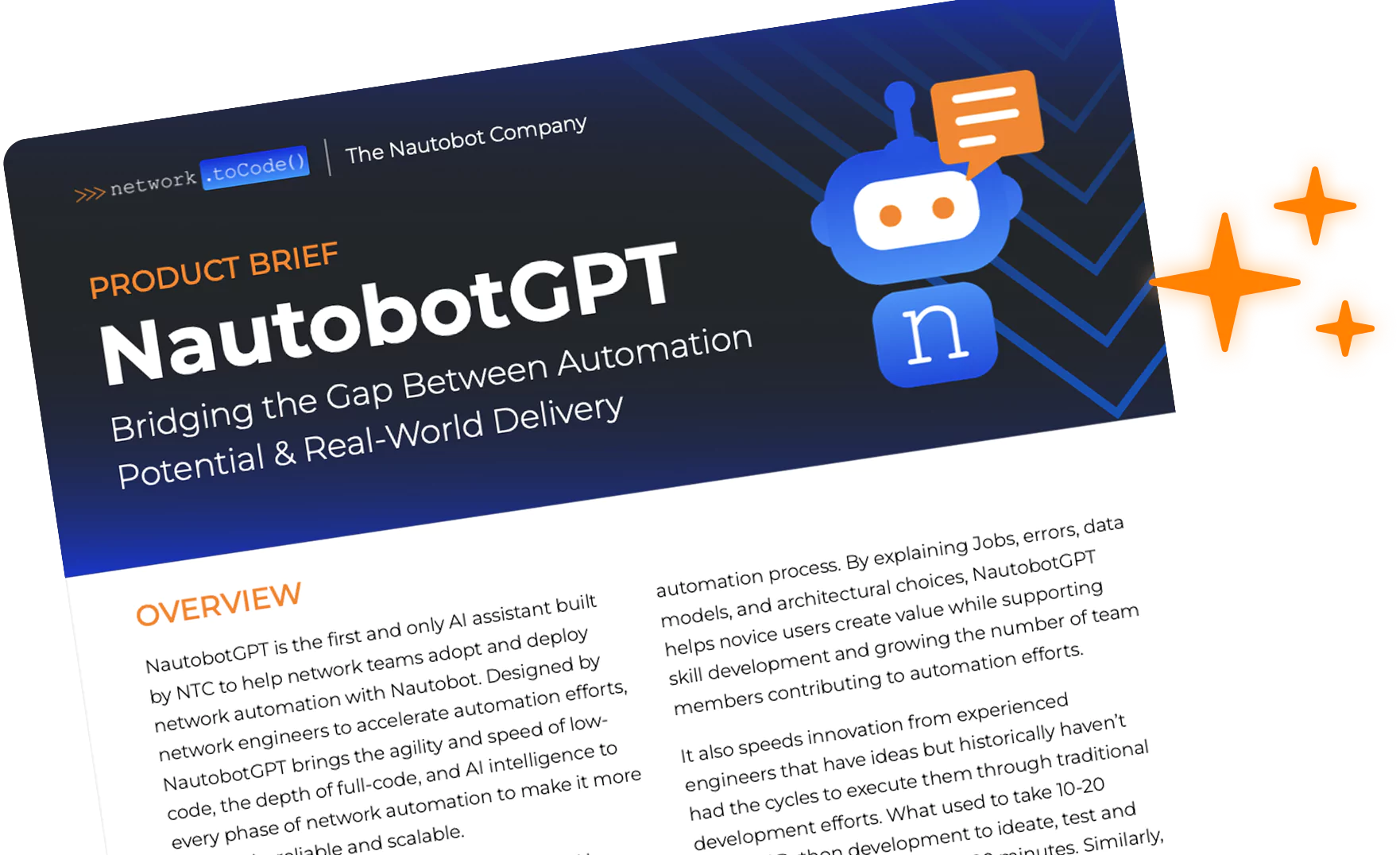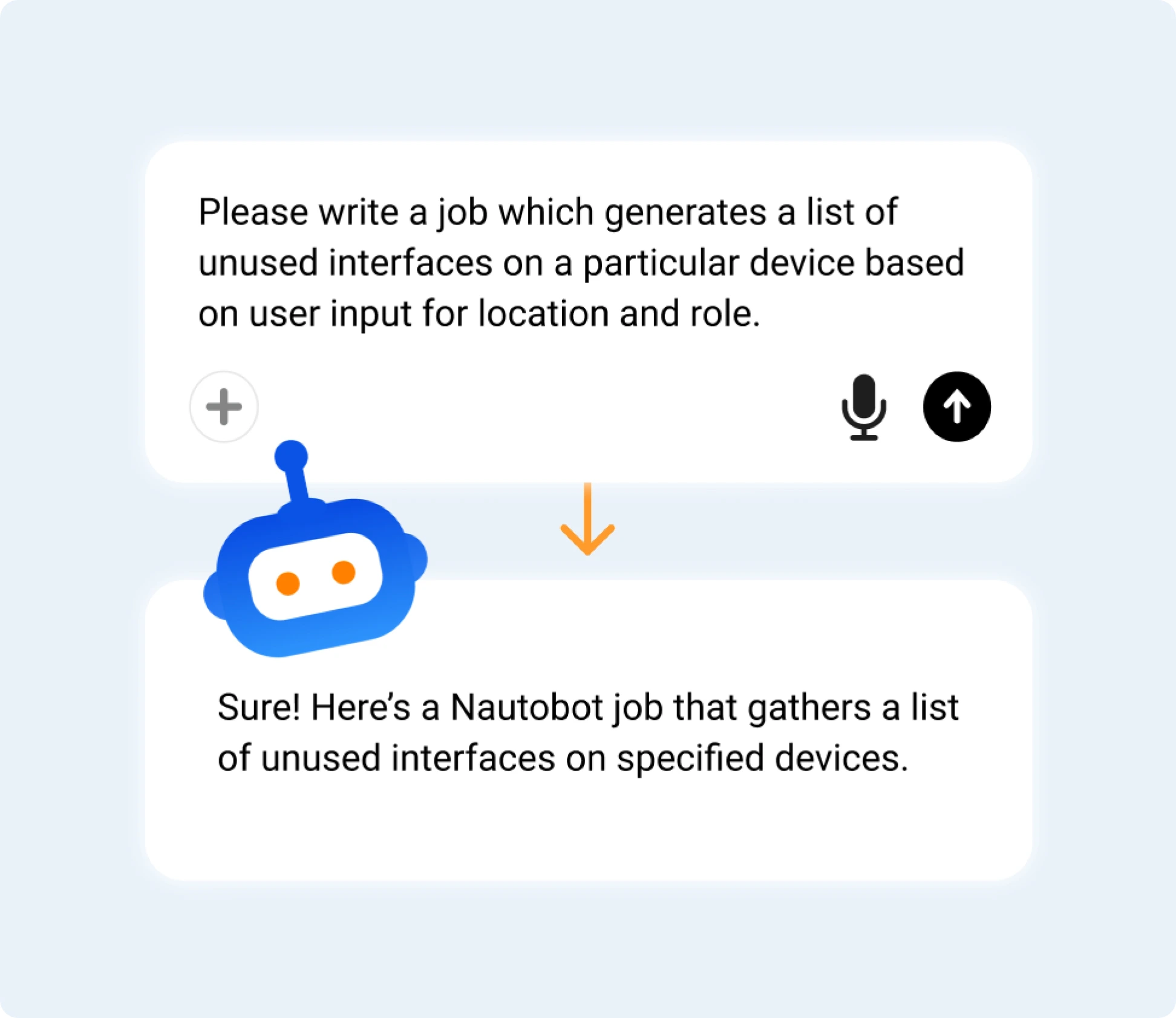Grounded in production-tested code, best practices, and expert patterns.
Ask technical questions in plain English and NautobotGPT will translate it into real, working code.
Quickly generate or refine Jobs with AI-assisted precision — no starting from scratch required.
Reduce friction, speed up iterations, and ship automation faster, without cutting corners.
Get answers and build automation from Day One.
Speed up dev cycles, skip boilerplate, focus on logic.
Scale automation, reduce time to value, and increase ROI.
Help teams ramp up quickly and deliver automation outcomes sooner.
Reduce time spent searching for answers and writing repetitive code.
Empower Junior Engineers and expand team participation.
Eliminate trial-and-error and improve output quality
Build, test, and deploy new automations faster.
Put trusted knowledge in every engineer’s hands.







Ask anything about Nautobot and get expert-level guidance.
Turn prompts into production-ready Jobs in minutes.
Paste tracebacks or broken logic — get step-by-step solutions.
Use natural language to query live data and trigger actions.
Walkthrough for app structure, models, and UI elements.
Generate filtered reports without scripting or SQL.
| Capacity | NautobotGPT | Low-Code Tools |
|---|---|---|
| Natural language input |
|
|
| Context-aware answers |
|
|
| Real Time Automation Generation |
|
|
| AI-based error resolution |
|
|
| Self-explaining code |
|
|
| Trained on real-world Nautobot data |
|
|
Experience the difference with NautobotGPT
Building a full Network Source of Truth can take months, but leaders expect meaningful results in 30 to 60 days. NautobotGPT helps close that gap. NauotobotGPT is already transforming how we deliver services by enabling engineers to move from idea to implementation in a fraction of the time. NautobotGPT amplifies our expertise, reduces rework, and drives faster, more confident decisions across the team.




General-purpose AI tools can offer suggestions, but they’re trained on broad, internet-sourced data, much of it unvalidated, and lack a deep understanding of how network automation actually works. NautobotGPT, by contrast, is trained on official documentation, production-tested code patterns, and the real-world experience of the engineers who build and deploy Nautobot. While it doesn’t access data from individual environments, its domain-specific training enables it to understand Nautobot deeply, delivering relevant and executable guidance every time.
Unlike rigid low-code or no-code platforms, NautobotGPT combines natural language input with deep contextual understanding of Nautobot and real-world automation patterns. It doesn’t rely on predefined templates or UI constraints. Instead, it generates flexible, Python-based solutions tailored to your intent. It can explain its own code, adapt to open-ended requests, and scale alongside your technical skill level. That makes it not just easier, but smarter and more capable, especially for teams serious about automation.
No. NautobotGPT is designed to support users across the experience spectrum, from those new to network automation to seasoned engineers building complex Jobs. By translating plain English into actionable code, troubleshooting errors, and offering contextual guidance, NautobotGPT accelerates workflows, reduces friction, and helps all users move from idea to implementation more efficiently. However, as with any AI results, responses may be incomplete or contain errors. Users should always validate outputs.
Yes. NautobotGPT is delivered as a SaaS offering and can be used to support a self-managed instance of Nautobot.
Reach out today to schedule a NautobotGPT demo.
Share details about yourself & someone from our team will reach out to you ASAP!